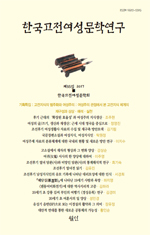- 영문명
- Ethical Justifications of Female Vengeance in the Late Chosŏn Literature
- 발행기관
- 한국고전여성문학회
- 저자명
- 심규영(Kyuyoung Sim)
- 간행물 정보
- 『한국고전여성문학연구』제50권, 187~218쪽, 전체 32쪽
- 주제분류
- 인문학 > 문학
- 파일형태
- 발행일자
- 2025.06.30
6,640원
구매일시로부터 72시간 이내에 다운로드 가능합니다.
이 학술논문 정보는 (주)교보문고와 각 발행기관 사이에 저작물 이용 계약이 체결된 것으로, 교보문고를 통해 제공되고 있습니다.

국문 초록
본 연구는 조선후기 시문(詩文)에서 여성의 복수(復讐)를 윤리적 결단으로 제시한 사례를 분석함으로써, 여성 인권에 대한 인식이 변화하고 이에 따라 윤리 담론이 심화되어 나간 사실을 조명하고자 한다.
조선전기에는 여성의 복수를 문학적으로 형상화한 예가 거의 없지만, 조선 후기에는 여성이 가족의 원수에게 보복하거나 개인적 명예를 지키기 위해 감행한 행위를 윤리적 결단으로 승인하고 공론화하려는 시도들이 시문에 나타났다. 이를테면 복수 살인의 경우 예서(禮書)와 법률서에서도 천살(擅殺)과 구별되는 의살(義殺)의 항을 두었지만, 그 설정은 국가적 차원에서 봉건 윤리를 현창하는 시책과 연관되어 있었다. 그런데 조선후기 일부 지식인들은 여러 형태의 여성 복수에 관심을 두고 그 복수 사실을 충동적 사건이 아니라 효(孝)·열(烈)·의(義)의 윤리적 결단 행위로서 정당화했다. 김창집(金昌集)·서종태(徐宗泰) 등은 작처의(酌處議)에서 여성 복수를 사회 교화의 효과를 가진 의열(義烈)로 평가했다. 이후 윤지당 임씨(允摯堂 任氏)는 「최홍이녀전」에서 여성의 복수를 국가적 복수설치의 유비(類比)로 평가하지 않고 여성 주체의 윤리적 결단 과정에 주목했다. 이익(李瀷)은 국가가 사적 복수를 대행하는 책임을 충실하게 부담해야 한다고 주장하는 한편, 박효랑 사건을 다루면서 허구적 서사를 개입시켜 민중의 복수 대행을 정당화하기까지 했다. 또한 여성 복수를 다룬 시문은 여협(女俠) 서사와 결합하여 더욱 섬세하고 풍부하게 발전했다. 성해응(成海應)과 이덕무(李德懋)는 여성이 정절 유린이나 참소에 대응해서 복수를 결행한 사례를 조명했다. 이덕무의 「김은애전(金銀愛傳)」은 응제(應製)의 특성상 군주의 교화 정치를 부각했지만, 성해응의 「김은애전」은 소설적 요소를 가미하여 여협(女俠)의 형상을 제시했다.
조선후기에 여성 복수를 다룬 시문은 여성 주체의 윤리적 판단과 자발적 실천에 주목했다. 그리고 부친이나 남편을 위한 복수뿐만 아니라, 여성 자신의 정절을 유린하거나 여성 자신을 모함한 자에 대한 응징 역시 윤리적 결단으로서 승인했다. 이는 근세에 이르러 새로운 여성관이 확립되기 시작한 전조를 보여주는 문학적 징후로 볼 수 있다.
영문 초록
This paper examines the transformation of female independence and ethical discourse in late Chosŏn literature, analyzing how female acts of vengeance were justified through ethical processes. In the early Chosŏn period, literary representations of female vengeance were rare. In contrast, during the late Chosŏn period, acts of female vengeance—often motivated by the desire to avenge family members or restore personal honor—were acknowledged as ethical actions and publicized in literature. As ideological texts and legal codes displayed contradictory concepts of “righteous murder” versus “arbitrary murder,” some acts of revenge were recognized as righteous killings and even praised nationally, leading to active literary discussion. Some late Chosŏn literati sought to justify female vengeance within the Confucian framework of filial duty and upright virtue, rather than dismissing it as a sudden outburst of emotion. For example, Kim Ch'angchip and Sŏ Chongt'ae evaluated female vengeance as heroic actions with educational significance. In “Ch'oehonginyŏjŏn” [The Biography of the Two Women, Ch'oe and Hong], Yunjidang Imssi emphasized the ethical determination of the female subject’s inner will, rather than connecting it to national ideals such as “the great righteousness of Chunqiu” or “wiping away disgrace.” Yi Ik argued that the government should be responsible for enacting justice by proxy. Regarding the case of Pak Hyorang, Yi extended a personal act of vengeance into the public domain through the fictional narrative of Pak Munrang, whose revenge was justified within the ethical framework of the public—contrasting with the historical reality that Pak Munrang was punished by law. In these narratives, female vengeance was portrayed as an act of chivalry, and the active agency of the female subject was magnified. Works such as Yu Hŭi's “Tohyŏpsŏ” and the “Kimŭnaejŏn” by Sŏng Haeŭng and Yi Tŏkmu highlighted cases where women took active revenge to defend their fidelity or counter slander, emphasizing female dignity and independence. These depictions are distinct from traditional narratives of righteous women who sacrificed their lives to maintain fidelity. While Yi Tŏkmu's “Kimŭnaejŏn” emphasized political edification for the sovereign, Sŏng Haeŭng’s version used fictional narrative to portray Kim Ŭnae as a paragon of female chivalry, showing the inevitable circumstances under which a woman became a chivalric figure to prove her personal worth. The stories of female vengeance in the late Chosŏn period illustrate the process by which ethical decision-making and action by female subjects were incorporated into broader ethical discourse. These narratives redefined female vengeance not as a momentary emotional outburst but as an ethically reasoned decision. In them, acts of revenge were justified not only for the death of a husband or father but also for violations of a woman's fidelity or slander against her character. Together, they represent a literary sign of the evolving concept of female independence and the emergence of a novel view of womanhood in late Chosŏn literature and society.
목차
1. 서론
2. 불공대천 원수에 대한 여성의 복수담
3. 정절 훼손범과 인격 모독범에 대한 여성 복수담
4. 결론
키워드
해당간행물 수록 논문
- 한국고전여성문학연구 제50권 목차
- <숙향전>에 나타난 꿈의 구조와 시간의 중첩을 통한 자아 통합의 의미 - 전생과 현생의 ‘얽힘과 풀림’을 중심으로
- 조선후기 시문 속 여성 복수(復讐)의 윤리적 정당화
- 외부자를 향한 내집단의 배타적 집단서사와 새로운 방향성 탐색 - 계모 설화 <콩밥 먹은 힘>을 중심으로
- 여성영웅소설과 로맨스 판타지 웹소설의 비교 연구
- 조선 장애여성의 돌봄, 그 이중적 의미
- 규방가사의 향유층과 기능에 대한 재고찰 - 현대적 계승의 관점을 포괄하여
- 『화랑세기』를 통해 본 치술, 선혜, 벽화의 삶
- 열녀 연구사에 대한 젠더 연구 관점의 검토와 과제, 그리고 제언
- 19세기 소설 속 ‘이상적 아내’의 일 양상 - <옥수기> 속 왕여란을 중심으로
참고문헌
교보eBook 첫 방문을 환영 합니다!

신규가입 혜택 지급이 완료 되었습니다.
바로 사용 가능한 교보e캐시 1,000원 (유효기간 7일)
지금 바로 교보eBook의 다양한 콘텐츠를 이용해 보세요!



